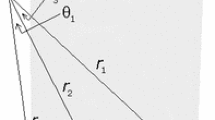Abstract
In this paper, the major direct solutions to the three point perspective pose estimation problems are reviewed from a unified perspective beginning with the first solution which was published in 1841 by a German mathematician, continuing through the solutions published in the German and then American photogrammetry literature, and most recently in the current computer vision literature. The numerical stability of these three point perspective solutions are also discussed. We show that even in case where the solution is not near the geometric unstable region, considerable care must be exercised in the calculation. Depending on the order of the substitutions utilized, the relative error can change over a thousand to one. This difference is due entirely to the way the calculations are performed and not due to any geometric structural instability of any problem instance. We present an analysis method which produces a numerically stable calculation.
Similar content being viewed by others
References
E. Church, “Revised Geometry of the Aerial Photograph,”Syracuse University Press, Bulletin 15, Syracuse, NY, 1945.
E. Church, “Theory of Photogrammetry,”Syracuse University Press, Bulletin 19, Syracuse, NY, 1948.
M. Dhome, M. Richetin, J. T. Lapreste and G. Rives, “The Inverse Perspective Problem from a Single View for Polyhedra Location,”IEEE Conference on Computer Vision and Pattern Recognition, 1988, pp. 61–68.
S. Finsterwalder and W. Scheufele, “Das Rückwärtsein-schneiden im Raum”Sebastian Finsterwalder zum 75.Geburtstage, Verlag Herbert Wichmann, Berlin, Germany, 1937, pp. 86–100.
M. A. Fischler and R. C. Bolles, “Random Sample Consensus: A Paradigm for Model Fitting with Applications to Image Analysis and Automated Cartography,”Graphics and Image Processing, Vol. 24, No. 6, 1981, pp. 381–395.
S. Ganapathy, “Decomposition of Transformation Matrices for Robot Vision, ”Proceeding of International Conf. on Robotics and automation, Rome, Italy, pp. 130–119, Nov., 1984.
E. W. Grafarend, P. Lohse, and B. Schaffrin, “Dreidimensionaler Rückw ärtsschnitt Teil I: Die projektiven Gleichungen”Zeitschrift für Vermessungswesen, Geodätisches Institut, Universität Stuttgart, 1989, pp. 1–37.
J. A. Grunert, “Das Pothenotische Problem in erweiterter Gestalt nebst Über seine Anwendungen in der Geodäsie,Grunerts Archiv für Mathematik und Physik, Band 1, 1841, pp. 238–248.
R. M. Haralick, H. Joo, C. N. Lee, X. Zhuang, V.G. Vaidya, and M. B. Kim, “Pose Estimation from Corresponding Point Data,”IEEE Trans. on Systems, Man, and Cybernetics, Vol. 19, No. 6, Nov./Dec. 1989.
B. K. P. Horn, “Closed-Form Solution of absolute Orientation Using Orthonormal Matrices,”J. Opt. Soc. Am. A, Vol. 5, No. 7, 1988, pp. 1127–1135.
R. Horaud, “New Methods for Matching 3-D Objects with Single Perspective Views,”IEEE Transactions on the Pattern Analysis and Machine Intelligence, Volume PAMI-9, No. 3, May 1987.
S. Linnainmaa, D. Harwood, and L. S. Davis, “Pose Estimation of a Three-Dimensional Object Using Triangle Pairs”IEEE Transactions on Pattern Analysis and Machine Intelligence, Vol. 10, No. 5, 1988, pp. 634–647.
P. Lohse, “Dreidimensionaler Rückwärtsschnitt Ein Algorithmus zur Streckenberechnung ohne Hauptachsentransformation,”Geodätisches Institut, Universität Stuttgart, 1989.
D. G. Lowe, “Three-Dimensional Object Recognition from Single Two-Dimensional Images,”Artificial Intelligence, Vol. 31, 1987, pp. 355–395.
E. L. Merritt, “Explicity Three-Point Resection in Space”Photogrammetric Engineering, Vol. XV, No. 4, 1949, pp. 649–655.
E. L. Merritt, “General Explicit Equations for a Single Photograph”Analytical Photogrammetry, Pitman Publishing Corporation, New York, USA, pp. 43–79.
F. J. Müller, “Direkte (exakte) Losung des einfachen Rückwartseinschneidens im Raume”Allgemeine Vermessungs-Nachrichten, 1925.
P. H. Schonemann, and R.M. Caroll, “Fitting One Matrix to Another Under Choice of a Central Dilation and a Rigid Body Motion.”Psychometrika, 35(2):245–255, June 1970.
P. H. Schonemann, “A Generalized Solution of the Orthogonal Procrustes Problem,”Psychometrika, 31(1):1–10, March 1966.
G. H. Schut, “On Exact Linear Equations for the Computation of the Rotational Elements of Absolute Orientation,”Photogrammetria 16 (1), 1960, pp. 34–37.
C. C. Slama, ed., “Manual of Photogrammetry”American Society of Photogrammetry, Falls Church, Virginia, 1980.
A.D.N. Smith, “The Explicit Solution of Single Picture Resection Problem with a Least Squares Adjustment to Redundant Control,”Photogrammetric Record, Vol. V, No. 26, October 1965, pp. 113–122.
E.H. Thompson, “Space Resection: Failure Cases,”Photogrammetric Record, Vol. V, No. 27, April 1966, pp. 201–204.
R.Y. Tsai, “A Versatile Camera Calibration Technique for High-Accuracy 3D Machine Vision Metrology Using Off-the-Shelf TV Cameras and Lenses,”IEEE Journal of Robotics and Automation, Vol. RA-3, No. 4, 1987, pp. 323–344.
J. Vlach and K. Singhal, “Computer Methods for Circuit Analysis and Design.” 1983.
J.H. Wilkinson, “Rounding Errors in Algebraic Process.” H.M. Stationery Office, London; 1963.
P.R. Wolf,Elements of Photogrammetry, McGraw Hill, New York, USA, 1974.
W.J. Wolfe, D. Mathis, C.W. Sklair, and M. Magee, “The Perspective View of Three Points,”IEEE Transactions on Pattern Analysis and Machine Intelligence, Vol. 13, No. 1, 1991, pp. 66–73.
Author information
Authors and Affiliations
Rights and permissions
About this article
Cite this article
Haralick, B.M., Lee, CN., Ottenberg, K. et al. Review and analysis of solutions of the three point perspective pose estimation problem. Int J Comput Vision 13, 331–356 (1994). https://doi.org/10.1007/BF02028352
Received:
Revised:
Issue Date:
DOI: https://doi.org/10.1007/BF02028352




